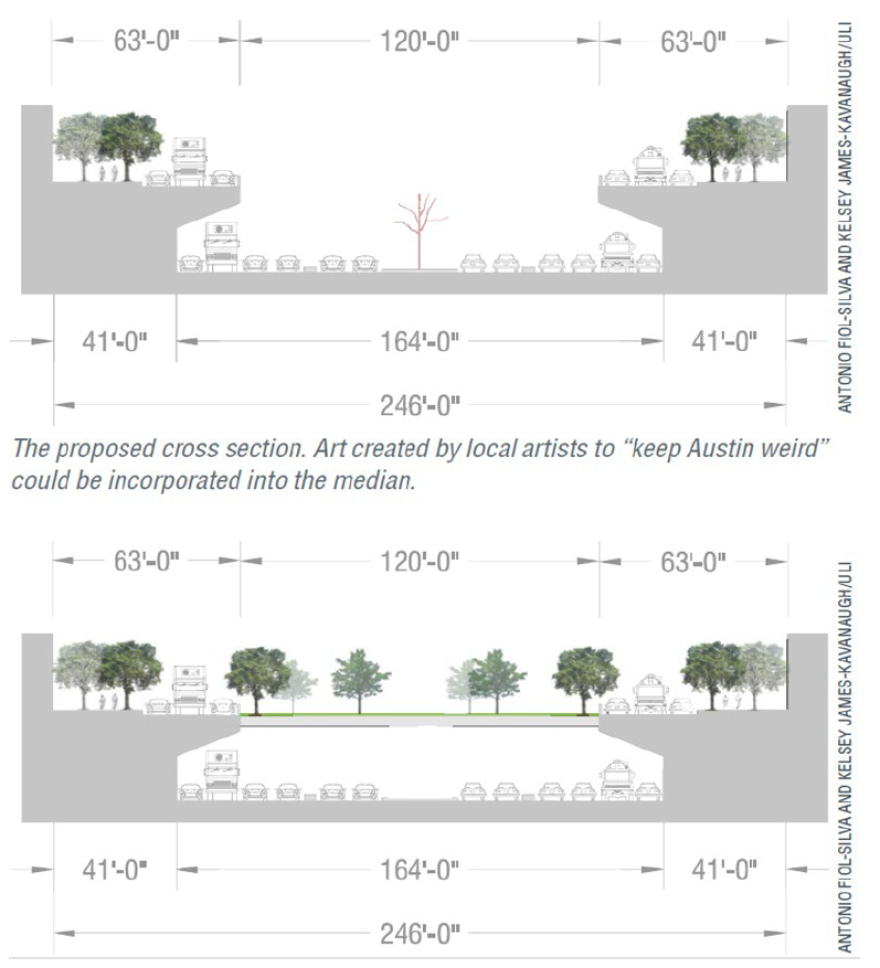The Texas Department of Transportation this week unveiled its latest proposals to widen the busiest stretch of highway in Central Texas to more than 20 lanes in some areas, significantly increasing Interstate 35's capacity for traffic while engulfing adjacent property. The state agency is soliciting public input for the next month.
The $4.9 billion plans — which include adding two non-tolled lanes in each direction, building direct connectors at I-35 and US 290 East, lowering the main lanes and eliminating the upper decks — have already drawn criticism from community groups that have advanced competing proposals to reduce I-35's footprint.
But TxDOT is not a huge fan of their ideas, either.
The plans the groups submitted to TxDOT were largely dismissed by the agency's academic partners at the Texas A&M Transportation Institute as being either bad for drivers or prohibitively expensive.
The first and arguably most dramatic proposal calls for shrinking the interstate to a transit-heavy urban boulevard.
Rethink35's concept imagines turning the highway into a six-lane road that would include dedicated bus lanes, parks, protected bicycle paths and wide sidewalks. The boulevard would be flanked by mixed-use buildings hosting restaurants and retail stores at the ground level with housing options above, some of which would be affordable homes offered to displaced households.
In short, I-35 would be transformed into the type of densely populated, pedestrian-friendly urban environment typical of many East Coast cities.
Rethink35's vision reflects a growing movement in the United States to remove highways that tore through neighborhoods decades ago, disproportionately displacing people of color and stamping out ground-level community amenities.
TTI argued ReThink35's proposal would push traffic congestion, including freight trucks, to neighborhood streets and other Austin highways, increasing commuters' travel times and compelling them to either move closer to their jobs or find employment within a reasonable distance from their homes.
Rethink35 said TTI's review of the proposal was scant.
"TTI's study was anemic from the outset. They were given hardly any time to a serious analysis of the community alternatives," said Adam Greenfield, co-founder of Rethink35. "I think it should basically ignored."
A second proposal from another community group calls for putting I-35 underground in the urban core and having the newly reclaimed ground-level space serve as a boulevard lined with affordable housing, green spaces, offices and stores. Reconnect Austin says the plan would create more than 136 acres of new developable land, increasing the city's tax base by billions of dollars.

The TTI analysis said many parts of the Reconnect Austin plan would meet TxDOT's highway capacity goals, but the Institute found that lowering I-35 and putting a lid on top "may be prohibitively expensive." TTI estimated the cost of such a covering from Cesar Chavez Street to MLK, Jr. Boulevard at close to $500 million. TxDOT could not pay for that, so the tab would have to be picked up by a third party.
Reconnect Austin said TTI failed to consider the additional revenue that its proposal would generate.
"I think there's some holes in the logic," Reconnect Austin co-founder Hayden Black Walker said. "Land in downtown Austin is incredibly valuable. If you narrow the footprint and use the land in a different way, you could actually have revenue to offset the cost, but TxDOT has never considered that."
The third community proposal analyzed by TTI would lower I-35 in the downtown area and push the frontage roads inward to hang over the main lanes, thereby reducing the space occupied by the interstate.
The plan from the Downtown Austin Alliance and the Urban Land Institute calls for adding "caps" (large decks covering the main lanes that would run north to south) and "stitches" (widened bridges running east to west over the highway). Proponents point to Klyde Warren Park in Dallas or the Cap at Union Station in Columbus, Ohio.

The TTI analysis was most amenable to the DAA/ULI vision, saying it was closest to the TxDOT proposals. But some of TTI's biggest concerns with the proposal included the engineering difficulty of routing on-ramps from overhanging frontage roads on to the main lanes without running into caps. TTI estimated the caps and stitches would cost between $198 million and $225 million, with maintenance and operations costs of around $2 million per year. TxDOT would not pay for the cost of covering I-35.
"I think there's a big amount of work to be done to identify funding for that," Downtown Austin Alliance Vice President of Planning Melissa Barry said. "The [Biden] administration is prioritizing that type of work. We think there will be more funding available in the future, so we're optimistic."
The public has until Sept. 8 to weigh in on TxDOT's plans, which call for construction to start in late 2025. And while the state agency says it's open to modifying its proposals for the interstate, TxDOT won't start over from scratch.
"We are still moving forward," TxDOT spokesperson Diann Hodges said. "There are still things that we can tweak about this, so we want to hear from the community to make sure we are getting this project right."












